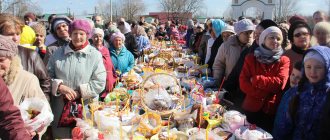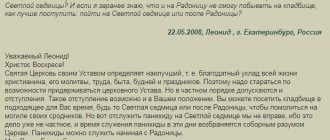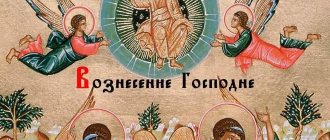Easter is the most important and brightest holiday for Christian believers. And although Orthodox and Catholics celebrate it separately, it has the same meaning - both remember the feat of Jesus Christ and His miraculous resurrection. After all, the Savior experienced mortal agony for people, thereby giving them hope for a better life. Celebrating Easter on Sunday is an established tradition, but the dates change every year.
Easter in the Christian religion is considered one of the most important holidays
How Orthodox Easter is considered: rules and examples
To determine how Easter day is counted, you need to proceed from 2 basic rules:
Although calendar spring begins on March 1, Christians begin counting from March 20. This is the day of the vernal equinox, when the lengths of day and night are equal to the nearest minute (12 hours each). Moreover, on the same day the so-called astronomical spring begins - already on the next day the length of the day becomes longer than the length of the night. This will continue until the autumn equinox (September 22-23). Starting from this day you need to wait for the first full moon. It is called the first of spring, as well as Easter. As soon as the Moon becomes full, Easter will be celebrated next Sunday.
However, another question arises here. In 2022, the first full moon will take place on March 21, and Easter will be celebrated only on April 28. What's the matter?
Here you need to keep in mind that the secular country of Russia lives according to the Gregorian calendar (new style), like most other countries in the world. However, the Orthodox Church still calculates all days according to the Julian calendar (old style), i.e. 13 later.
A classic example is the same old New Year, which, as we know, is celebrated on the night of January 13-14.
Thus, from this point of view it is very simple to understand how Easter is calculated among the Orthodox :
We proceed from the fact that spring begins on April 2 (according to the old style, i.e. according to the Julian calendar, which is still used in Orthodoxy). We determine the full moon closest to this date according to the Lunar calendar. Next Sunday is Orthodox Easter.
Rules for calculating the Jewish Passover from Old Testament times:
- the basis of calculations is the lunar calendar
- basic unit - month
- month length - 29 or 30 days
- full moon - 14th day of any month
- the length of the year is 12 months - shorter by 10 days of the solar year
- if a year has 13 months, then the year is 20 days longer than the solar one
- to fix holidays on certain dates - adjusting the lunar and solar calendars - this was done by periodically adding the 13th month. The decision to add a month was made by the high priest. The year was supposed to begin in the spring month, when the first barley harvest appears - the month of Nisan .
For different places, on average, the beginning of the month of Nisan was delayed in relation to the equinox for a period of 8 to 20 days. The difference in these estimates is due to the fact that the barley crop in mountainous areas ripens later than in the valleys. It must be emphasized that in any case we are talking about the delay on average. There were years when Jews celebrated their Passover before the equinox, and in other years - much later.
For the Romans and Greeks, spring always came after the vernal equinox. There was disagreement about the exact date of this astronomical event, but almost everyone agreed to accept some constant date of the Julian calendar, neglecting the fluctuations of the actual astronomical equinox within the four-year leap cycle. Jews became interested in the calendar, associated with astronomical phenomena and the date of the vernal equinox, only after the destruction of Jerusalem by Titus.
How to determine the date of Easter
In addition to the above method, there is also an arithmetic one. It consists of simple operations and numbers and was invented by Gauss, a German mathematician and scientist in the 19th century.
Easter is celebrated on the first Sunday after the spring full moon
First you need to divide the number of the desired year by 19 and select the remainder. The same thing needs to be done two more times, but with the numbers 4 and seven. We have 3 remainders after each action. Now we multiply the first remainder by 19 and divide by 30, find the remainder. We multiply the second remainder by 2, the third by 4, the fourth by 6. We add the resulting data and add 6, divide by 7. We find the remainder again.
If the sum of the fourth and fifth balances is less than 9, then the month of celebration is March. Now all that remains is to determine the date. Let's add the fourth and fifth remainders and add 22. The resulting number is the date of the celebration.
If the sum of the fourth and fifth remainders is greater than 9, then the month of celebration is April. To determine the date, add the fourth and fifth remainders and subtract 9. The resulting number is the date of the celebration. This method will be relevant until 2101. Later, due to a break in calendars, it will be slightly changed.
When is Easter for Catholics?
In 1583, Pope Gregory XIII introduced a new Paschal in the Roman Catholic Church, called the Gregorian. Due to the change in Easter, the entire calendar also changed. As a result of the transition to more precise astronomical dates, Catholic Easter is often celebrated earlier than Jewish Easter or on the same day, and precedes Orthodox Easter in some years by more than a month. The discrepancy between the dates of Orthodox Easter and Catholic Easter is caused by the difference in the date of church full moons, and the difference between solar calendars - 13 days in the 21st century. Western Easter in 45% of cases is a week earlier than Orthodox, in 30% of cases it coincides, 5% is a difference of 4 weeks, and 20% is a difference of 5 weeks (more than the lunar cycle). There is no difference of 2-3 weeks. Catholic Easter can be calculated using the following algorithm: 1. G = (Y mod 19) + 1 (G is the so-called “golden number in the Metonic” cycle - the 19-year full moon cycle) 2. C = (Y/100) + 1 ( if Y is not a multiple of 100, then C is the number of the century) 3. X = 3*C/4 – 12 (adjustment for the fact that three of the four years that are multiples of 100 are not leap years) 4. Z = (8*C + 5)/ 25 – 5 (synchronization with the lunar orbit, the year is not a multiple of the lunar month) 5. D = 5*Y/4 – X – 10 (in March, day ?D mod 7 will be Sunday) 6. E = (10*G + 20 + Z - X) mod 30 (epact - indicates the day of the full moon) 7. IF (E = 24) OR (E = 25 AND G > 11) THEN increase E by 1 8. N = 44 - E (Nth March - day of the calendar full moon) 9. IF N 10. N = N + 7 - (D + N) mod 7 11.IF N > 31 THEN the date of Easter (N ? 31) April ELSE the date of Easter N March Photo - Lori's photo bank
Easter in 2022 is April 28!
The Resurrection of Christ (Easter) is the most important Christian holiday, established in remembrance of the Resurrection of Jesus Christ from the dead. The Charter of the church service depends on the date of Easter (from this day the countdown of the “pillars” of osmoglasia begins), and the end of the longest and strictest Lent (breaking the fast) and many other Orthodox holidays. Even for people far from religion, Holy Easter is associated with a nightly solemn service, a procession of the cross and Easter cakes, colored eggs and the ringing of bells. What is the spiritual meaning of Easter and what are its traditions? — More on this in the article below.
Content
Easter of Christ. How many days are celebrated? Event of Easter: excerpt from the Gospel Celebration of Easter in history. Why is Sunday called Sunday?What date is Easter for the Orthodox?How to calculate the date of Easter?Orthodox Easter serviceTraditions of celebrating Easter among the Old BelieversThe Resurrection of Christ. IconsTemples of the Resurrection of ChristOld Believer Churches of the Resurrection of ChristChristian Easter and Passover among the Jews (Jewish Passover) in 2022New Paschalists and their teachings
Easter dispute
After the Resurrection of Jesus Christ, as historians testify, the first Christians first held a special fast, which coincided in time with the Jewish one. It continued until the next Sunday, on which oh, or Sunday.
Over time, the second celebration became the main one; by the second century it acquired the significance of the annual main celebration for all Christians. Most believers celebrated the Resurrection of Christ on the following Sunday after the Jewish Passover. But not all.
Christians in Assyria used their own calendar. The churches of Asia Minor, citing the authority of the Apostle John the Theologian, adhered to Jewish custom. They always celebrated Easter on the 14th day of Nisan , for which they were also nicknamed the Fourteeners, or Quadrodecimans.
The most common among all believers were the Alexandrian Paschals. The Western world celebrated Easter on the Sunday after the Jewish Sunday, defining the latter as the full moon after the vernal equinox.
Such a difference in determining the date of celebration of the main event, on which many other dates depended, could not help but bring confusion into church life, as a result of which the so-called “Easter disputes” arose. The First Ecumenical Council , which was held in 325 in Nicaea, was called upon to solve them .
Why is Easter celebrated on different dates?
In the Orthodox religion, there are both transitory holidays, that is, the date of celebration, which does not have a clearly established day, and enduring ones, namely those celebrations that take place on the same day every year.
One of the main moving holidays, on the day of which almost the majority of the liturgical yearly cycle depends, is Easter. As a rule, the days of celebrating Pentecost, the Feast of the Entry of the Lord into Jerusalem, the Ascension, the beginning of Lent and more depend on it. On this day, Christians bake Easter cakes, paint eggs, and clean the house.
Easter in the Old Testament
The celebration of Easter among the Jews was established by the prophet Moses in honor of the exodus of the Jews from Egypt (see Passover). “Keep the Passover to the Lord your God, for in the month of Nissan (Aviv) the Lord your God brought you out of Egypt by night” (Deut. 16:1). In memory of the Exodus on Passover, the ritual slaughter of a one-year-old male lamb, without blemish, was prescribed; it should be baked on fire and eaten completely, without breaking the bones, with unleavened bread (unleavened, unleavened bread) and bitter herbs in the family circle during the Passover night ( Ex.12:1-28; Num.9:1-14). After the destruction of the temple in Jerusalem, ritual slaughter became impossible, so Jews eat only unleavened bread - matzah - on Passover.
How Easter is calculated for each year: Gauss's formula
And now a few words about how to calculate Easter yourself. In general, you may not even know when exactly the full moon occurs. In this case, the date can be determined for any year – at least 10 years in advance.
For this, the so-called Gauss formula is used. At first glance, it seems quite complicated, although in fact, to understand it, it is enough to know only simple arithmetic.
So, for the calculation we need to determine 5 values - let's call them A, B, C, D and E. We also need the year in which we determine the day of celebration. Let's take 2022 as an example.
The algorithm for how Easter day is considered in Orthodoxy (i.e. according to the old calendar) is as follows:
First we divide 2022 by 19. We get the remainder 5 - this is the value A. We divide 2022 by 4. We get the remainder 3 - this is the value B. Divide 2022 by 7. We get the remainder 3 - this is the value C. Now we perform the following actions: (19*A+ 15)/30. From this division we also need to take only the remainder - this is 20 (the value of D). Now we perform the following actions: (2B+4C+6D+6)/7. Again we take the remainder of the division - in this case it is equal to 4 (the value of E).
Now you need to choose one of these formulas:
22+D+E (this is how the date in March is determined). D+E-9 (this is how the date in April is determined).
To understand which formula to choose, let’s do calculations for each of them: in the first case, it turns out 22 + 20 + 4 = 46. This number will not work, because there are no more than 31 days in 1 month. So, we take the second formula: 20 + 4-9 = 15. Now we add 13, since we need to take into account the difference between the old and new style. We get April 28 - it is on this day that Easter will be celebrated in 2022.
Why do Orthodox and Catholics have different Easter days?
Why Catholics and Orthodox Christians celebrate this great holiday on different days is of interest to many. In order to understand what the essence is, you need to go back to the origins of history.
Back in the third century, the question of determining the date for the celebration of the Resurrection of the Lord was raised. Disagreements arose between churches due to the existence of several astronomical cycles.
Catholic Easter in 2022 is celebrated on April 4
Due to the fact that the church calendar lagged behind astronomical calculations, a need arose for reform. To avoid confusion with dates, a new calendar should be introduced, taking into account the requirements of the church and natural astronomical phenomena.
Such a reform was carried out in 1582. And its author was Pope Gregory XIII, in whose honor the new calendar was named Gregorian.
According to the innovations, October 4 of the same year was followed by the fifteenth. Thus, the 10 days not taken into account by the Julian version of the calendar were discarded. And the calendar has finally become unified.
Since the same year, some countries switched to the Gregorian calendar, but the Orthodox churches and Protestants did not support such a reform, remaining in their opinion and continued to use the old style of the calendar in their calculations, which is still used to this day.
The date of Easter in Orthodoxy is determined in accordance with the 7th Apostolic Canon
Due to the fact that the difference between the new and old calendar is 13 calendar days, Orthodox and Catholics have different dates for the celebration. Interestingly, the difference between the dates of the celebration can be one week, four or five, but there is never a difference of two or three weeks.
How is the date of Easter calculated?
Previously, in Russia, even uneducated peasants could easily determine the date of Easter. They simply counted down 48 days from the beginning of Lent. Almost everyone followed it then, so the date of Easter was known. This was perhaps the only way. Since few people are fasting now, you can use another method. Here is his algorithm:
Determine the day of the vernal equinox. Find out when the first full moon occurs after it. The first Sunday after the full moon is the day of Holy Easter.
You will notice that the method is quite easy. It does not require any knowledge. All data can be provided by the Internet.
Scientists have determined that according to the Gregorian calendar, the earliest Holy Easter was April 4, and the latest was May 8. Orthodox and Catholic Easter will never go beyond this range.
Ways to independently determine the date
Since the Russian Orthodox Church counts the day of Bright Sunday according to the old style, one way to calculate this day is to start from the Julian and lunar calendar. According to the first, spring begins on the second day of the second spring month.
The first Sunday after the full moon is Easter
Using the lunar calendar, the nearest full moon is determined. Thus, the first next Sunday will be the day of celebration.
On the eve, parishioners observe Lent, lasting 48 days. After it ends, on the next Sunday, Christians celebrate the Resurrection of Christ. This is probably one of the simplest ways to calculate what day the Easter celebration falls on.
In the 17th century, mathematician Carl Gauss developed a special method by which you can calculate the date of the celebration yourself. It consists of the following calculation steps:
- X/19=v
- X/4=s
- X/7=f
Where X is the number of the desired year, and vsf is the remainder of the amount received. Thus, after each action there are three remainders.
The following calculations look like this:
19*v-15/30= remainder “p”
2*s +4*f+6*p+6 /7= remainder “z”
22+p+e = the resulting number will be Easter day for March (old style).
p+z-9 = Easter number for April.











